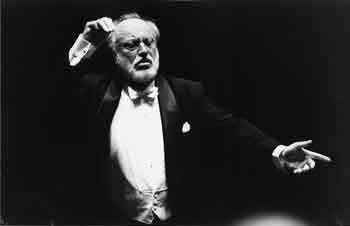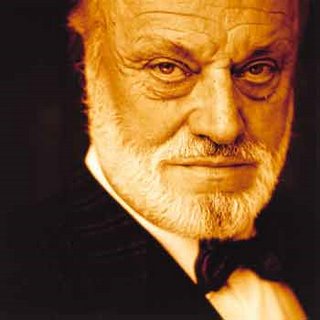 Kurt Masur (thankfully healthy again), all torso that he is and appearing several inches taller than he actually measures, towers over an orchestra; by name and stature anyway but also by sheer physical presence. The natural posture of leadership he assumes must be what does the trick. Bring his name up among recording enthusiasts, meanwhile, and he will provoke little more than a prolonged yawn – at best he is ascribed “utter competence” or said to be a Kapellmeister of the first order, excellent Tchaikovsky (Teldec) and good Mendelssohn (Eurodisc) notwithstanding. “Too German even for German repertoire” is the damning quip. His Beethoven symphony cycle (on Philips and restored onto SACD by Pentatone) is considered more solid than inspired. In person, however, there aren’t many conductors of his rank and Beethoven expertise to be found. The way he led the National Symphony Orchestra in an all-Beethoven program Thursday night only underscored that.
Kurt Masur (thankfully healthy again), all torso that he is and appearing several inches taller than he actually measures, towers over an orchestra; by name and stature anyway but also by sheer physical presence. The natural posture of leadership he assumes must be what does the trick. Bring his name up among recording enthusiasts, meanwhile, and he will provoke little more than a prolonged yawn – at best he is ascribed “utter competence” or said to be a Kapellmeister of the first order, excellent Tchaikovsky (Teldec) and good Mendelssohn (Eurodisc) notwithstanding. “Too German even for German repertoire” is the damning quip. His Beethoven symphony cycle (on Philips and restored onto SACD by Pentatone) is considered more solid than inspired. In person, however, there aren’t many conductors of his rank and Beethoven expertise to be found. The way he led the National Symphony Orchestra in an all-Beethoven program Thursday night only underscored that.Tim Page, NSO Blossoms With Kurt Masur And Beethoven (Washington Post, June 1) |
In comparison to that overture, the classical 1st Symphony – even in as substantial and dignified reading as Masur gave it – offered glimpses at a genius in the making; a composer with much to say, but not yet quite ready to articulate it. Usually the work’s debts to the symphonies of Haydn and Mozart are played out more overtly – here the gravitas of “Beethoven” already hung thick over it. The result was impressive if leaving the impression of the symphony as a poser: pretending to be the real thing without quite offering enough of its own substance to justify it.
 Being asked to pick your favorite Beethoven symphony is a bit akin to being asked which of your children you love most. Maybe there is one that comes to mind – but only at the price of feeling guilty leaving out another. Even leaving aside the two earlier works, one cannot say “three” without thinking “four,” “six” without wishing to have said “seven.” The way out is to announce to love best whichever one currently hears. And the 7th Symphony certainly makes that very easy, full of contrast as it is, with its abundance of light and darkness.
Being asked to pick your favorite Beethoven symphony is a bit akin to being asked which of your children you love most. Maybe there is one that comes to mind – but only at the price of feeling guilty leaving out another. Even leaving aside the two earlier works, one cannot say “three” without thinking “four,” “six” without wishing to have said “seven.” The way out is to announce to love best whichever one currently hears. And the 7th Symphony certainly makes that very easy, full of contrast as it is, with its abundance of light and darkness.With Masur, it was a bit more on the dark than the light side; brooding and broad the first movement alone. The playing, generally good that night if not technically exemplary (although one wondered how the NSO could have read much of anything from Masur’s suggestive, rather than precise, hand movements) was emotionally charged and well above the autopilot mode they’ve been caught in a few too many times with Slatkin this season. Even if the brass had occasional glitches and sounded bright/borderline brittle (strident trumpets, though), it was a big-boned, traditional, and eminently pleasing performance. Slightly faster – actually Allegretto – than expected in the funereal second, ostensibly slow, movement, Masur offered delicate shadings and dynamics; no repetition of a theme ever occurring as the one before it. Although tenderness and lyrical moments were well present, the conception felt mostly sturdy; the weight of history and reverence on its shoulders here as in the other movements. Driven and explosive but not ‘light on its toes’ – hence purveying aggressiveness more than gaiety – was the third movement before Masur throned over the rest of a regal Presto. The accumulating power of the fourth movement came with consequent glory and fanfares, was weighty, and very (self-)important.
This was Beethoven with an extra layer of Beethoven on top, not recasting the symphony before our ears but a splendid, unabashedly old-fashioned reading instead. One that should well be able to give Washington audiences some of the finest central European, traditional Beethoven they have heard in a while, be it at 1.30PM today or on Saturday at 8PM (apparently sold out: call the box office directly).
